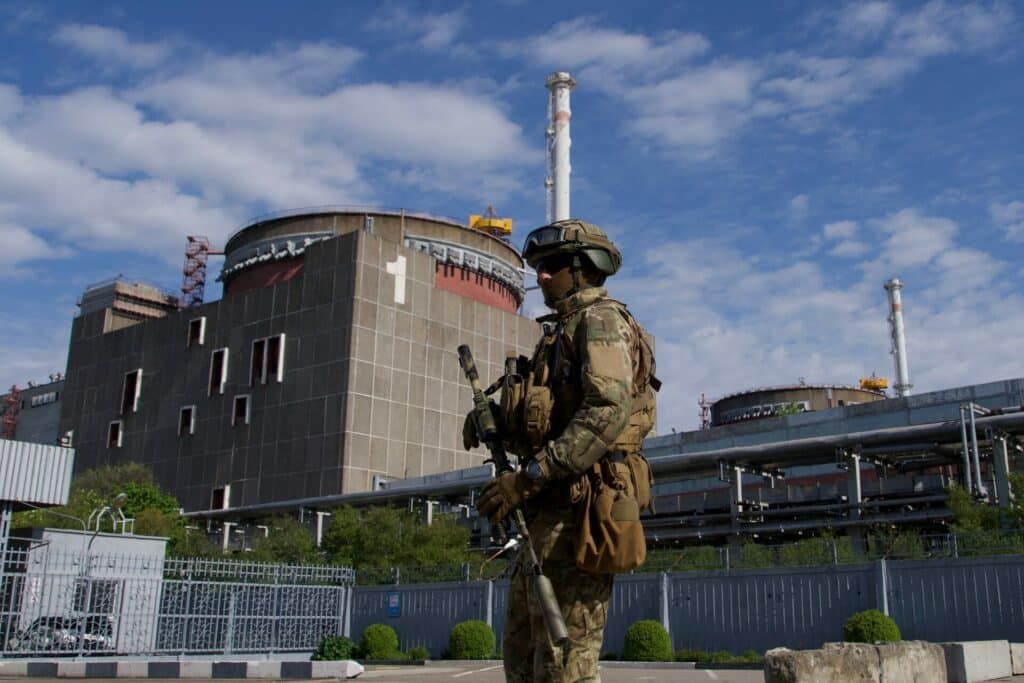Rockets fired at Ukrainian nuclear power plant; Ukraine and Russia blame each other
By John Mecklin | August 7, 2022
 A Russian serviceman patrols the territory of the Zaporizhzhia Nuclear Power Plant on May 1, 2022. The Zaporizhzhia Nuclear Power Plant in southeastern Ukraine is Europe's largest and among the 10 largest in the world. (Editor's note: This picture was taken during a media trip organized by the Russian army.) (Photo by ANDREY BORODULIN/AFP via Getty Images)
A Russian serviceman patrols the territory of the Zaporizhzhia Nuclear Power Plant on May 1, 2022. The Zaporizhzhia Nuclear Power Plant in southeastern Ukraine is Europe's largest and among the 10 largest in the world. (Editor's note: This picture was taken during a media trip organized by the Russian army.) (Photo by ANDREY BORODULIN/AFP via Getty Images)
Ukraine claimed that Russia had fired rockets on Saturday at a spent fuel storage area at the Zaporizhzhia Nuclear Power Plant in southern Ukraine, risking what the country’s nuclear power company called a “nuclear disaster.” A Russian official claimed the attack had come from Ukraine.
Though accounts of the attack were confused and at times conflicting, no damage to reactors or fuel containers or release of radiation was reported. The attack on Saturday followed shelling on Friday at the plant for which Ukraine and Russia also blamed on one another.
The Ukrainian state nuclear company Energoatom contended that in Saturday’s attack “Russian nuclear terrorists” fired rockets at Zaporizhzhia’s dry spent nuclear fuel storage facility, which holds 174 casks, each containing 24 spent nuclear fuel assemblies. The company called for a withdrawal of Russian forces from the nuclear power plant, which they have controlled since its March capture, and the establishment of a demilitarized zone around the plant.
Energoatom said that although Saturday’s missile attack damaged three radiation monitoring sensors near the fuel storage facility, impairing the ability to detect a radiation leak should one occur, “[t]his time a nuclear catastrophe was miraculously avoided, but miracles cannot last forever.”
Local officials Russia has installed in southern Ukraine and the Russian Defense Ministry blamed the attacks on Ukraine.
On Saturday, International Atomic Energy Agency Director General Rafael Mariano Grossi said the situation posed “the very real risk of a nuclear disaster that could threaten public health and the environment in Ukraine and beyond.” Sunday Grossi “demanded that he be allowed to visit the site with a team of nuclear experts,” the Washington Post reported.
Ukrainian President Volodymyr Zelensky tweeted that “Russian nuclear terror requires a stronger response from the international community—sanctions on the Russian nuclear industry and nuclear fuel.”
Talked with @eucopresident Charles Michel, told about the situation on the battlefield, in particular at the Zaporizhzhia NPP. Russian nuclear terror requires a stronger response from the international community – sanctions on the Russian nuclear industry and nuclear fuel. (1/2)
— Володимир Зеленський (@ZelenskyyUa) August 7, 2022
The Russian Defense Ministry meanwhile called on international organizations “to condemn the criminal actions of the Kiev authorities, which engage in acts of nuclear terrorism,” according to the TASS news agency. If Ukraine engaged in “further provocations” at the Zaporizhzhia nuclear power plant, “the entire responsibility for disruptions in its operation will rest on the Kiev authorities,” TASS quoted the foreign ministry as saying.
The Zaporizhzhia plant has been under Russian control since March, but it is staffed by Ukrainian workers who reportedly have had insufficient relief, a situation that Grossi and other experts have repeatedly called dangerous. Russian forces fired artillery shells at an administrative building at the plant when they occupied it in March. “My technical assessment of the potential consequences hasn’t changed from back in March, but it does appear now that the likelihood of some damage that could potentially endanger the reactors and spent fuel storage is increasing, and Russia’s use of the facility as a shield to deter Ukrainian counterattacks is, of course, an outrage and possibly a war crime,” Ed Lyman, director of nuclear power safety at the Union of Concerned Scientists, said. “And the stress the Ukrainian plant staff is under must be at a breaking point, only strengthening the concern about their ability to react in the event that the plant is damaged in a way that requires operator action to save it.”
Energoatom has claimed Russia is attacking the nuclear power plant with the aim of “destroying the station’s infrastructure, damaging all power lines through which electricity is supplied to the Ukrainian power system, and cutting off power in the south of the country.” But the firm’s claim seems to ignore a stark reality: Russia is in control of the Zaporizhzhia plant and could presumably cut the lines without using artillery and rockets.
It remains unclear, therefore, why either Russia or Ukraine would intentionally attack a nuclear power plant, given the dangers that a large release of radiation from either a reactor or spent nuclear fuel could bring, not just to Ukraine but to surrounding countries, including Russia.[1] The plant, the largest in Europe, is on the Dnieper River, near the front line of fighting. Russian forces hold the plant, on the south side of the river, with Ukrainian forces holding the territory across the river from the plant.
Notes
[1] For simulations of the extent of such a catastrophe, see: https://thebulletin.org/2022/03/could-an-attack-on-ukrainian-nuclear-facilities-cause-a-disaster-greater-than-chernobyl-possibly-simulations-show/#post-heading
Together, we make the world safer.
The Bulletin elevates expert voices above the noise. But as an independent nonprofit organization, our operations depend on the support of readers like you. Help us continue to deliver quality journalism that holds leaders accountable. Your support of our work at any level is important. In return, we promise our coverage will be understandable, influential, vigilant, solution-oriented, and fair-minded. Together we can make a difference.














